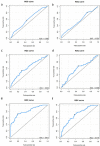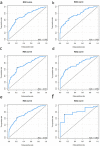The development and validation of a CT-based radiomics signature for the preoperative discrimination of stage I-II and stage III-IV colorectal cancer
- PMID: 27120787
- PMCID: PMC5058766
- DOI: 10.18632/oncotarget.8919
The development and validation of a CT-based radiomics signature for the preoperative discrimination of stage I-II and stage III-IV colorectal cancer
Abstract
Objectives: To investigative the predictive ability of radiomics signature for preoperative staging (I-IIvs.III-IV) of primary colorectal cancer (CRC).
Methods: This study consisted of 494 consecutive patients (training dataset: n=286; validation cohort, n=208) with stage I-IV CRC. A radiomics signature was generated using LASSO logistic regression model. Association between radiomics signature and CRC staging was explored. The classification performance of the radiomics signature was explored with respect to the receiver operating characteristics(ROC) curve.
Results: The 16-feature-based radiomics signature was an independent predictor for staging of CRC, which could successfully categorize CRC into stage I-II and III-IV (p <0.0001) in training and validation dataset. The median of radiomics signature of stage III-IV was higher than stage I-II in the training and validation dataset. As for the classification performance of the radiomics signature in CRC staging, the AUC was 0.792(95%CI:0.741-0.853) with sensitivity of 0.629 and specificity of 0.874. The signature in the validation dataset obtained an AUC of 0.708(95%CI:0.698-0.718) with sensitivity of 0.611 and specificity of 0.680.
Conclusions: A radiomics signature was developed and validated to be a significant predictor for discrimination of stage I-II from III-IV CRC, which may serve as a complementary tool for the preoperative tumor staging in CRC.
Keywords: colorectal cancer; computed tomography; predictor; radiomics signature; stage.
Conflict of interest statement
The authors do not have any possible conflicts of interest.
Figures





References
-
- Compton CC, Greene FL. The staging of colorectal cancer: 2004 and beyond. CA Cancer J Clin. 2004;54:295–308. - PubMed
-
- Acunas B, Rozanes I, Acunas G, Celik L, Sayi I, Gokmen E. Preoperative CT staging of colon carcinoma (excluding the recto-sigmoid region) Eur J Radiol. 1990;11:150–153. doi: 10.10160720-048X90166-9. - PubMed
MeSH terms
LinkOut - more resources
Full Text Sources
Other Literature Sources
Medical
Research Materials

